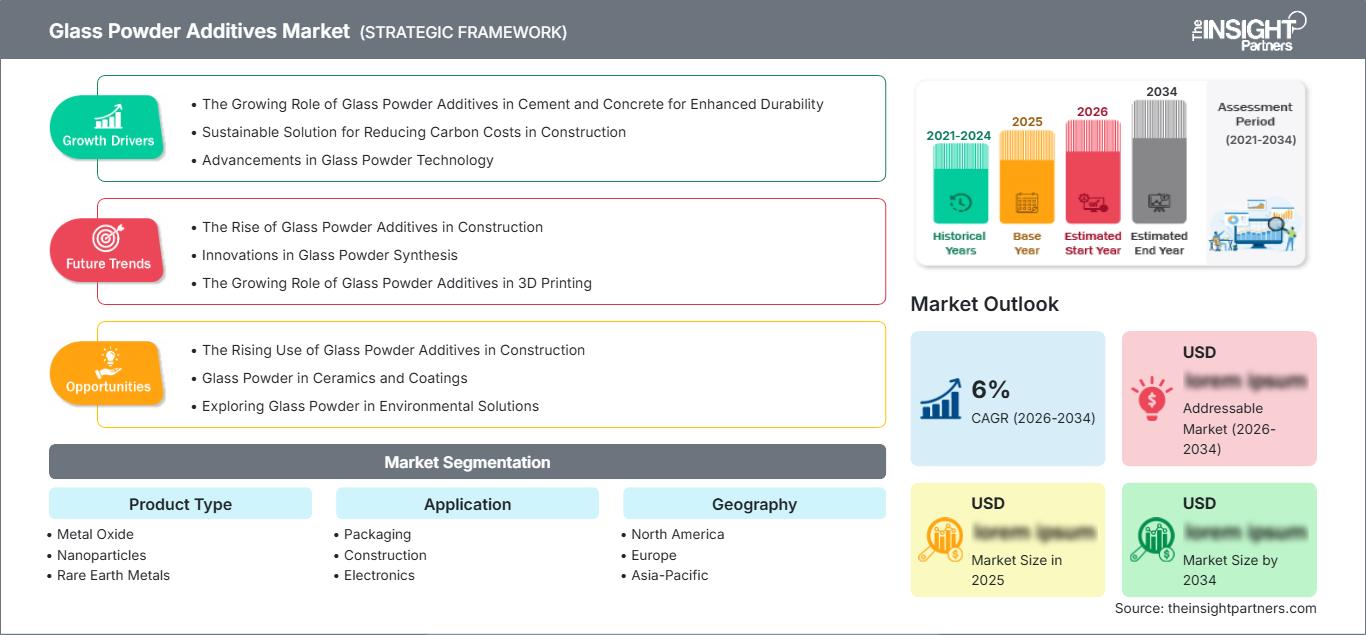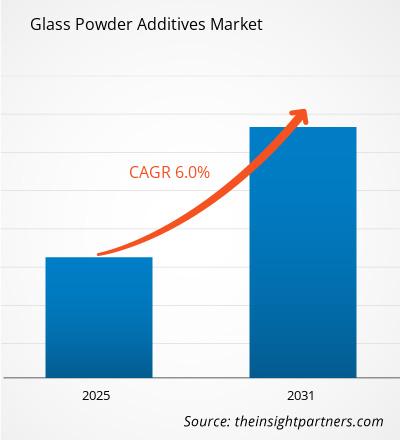Le marché des additifs pour poudres de verre devrait croître à un TCAC de 6 % entre 2026 et 2034. L'évolution constante du marché offre de nouvelles opportunités aux acteurs du secteur. Le contexte général témoigne d'une progression stable et d'un fort potentiel de croissance à long terme.
Le rapport est segmenté par type de produit (oxydes métalliques, nanoparticules, terres rares). L'analyse globale est ensuite ventilée par région et par principaux pays. Le rapport présente également une analyse par application (emballage, construction, électronique, autres). L'analyse globale est également ventilée par région et par principaux pays. La taille du marché et les prévisions aux niveaux mondial, régional et national pour tous les segments clés sont incluses dans le périmètre du rapport. Les valeurs des analyses et segments sont exprimées en dollars américains. Le rapport fournit des statistiques clés sur la position des principaux acteurs du marché et présente les tendances et opportunités du marché.
Objectif du rapport
Le rapport « Marché des additifs pour poudres de verre » de The Insight Partners vise à décrire le paysage actuel et la croissance future, les principaux facteurs de croissance, les défis et les opportunités. Il fournira des informations précieuses à divers acteurs du secteur, tels que :
- Fournisseurs de technologies/Fabricants : Pour comprendre l’évolution de la dynamique du marché et connaître les opportunités de croissance potentielles, afin de prendre des décisions stratégiques éclairées.
- Investisseurs : Réaliser une analyse complète des tendances concernant le taux de croissance du marché, les projections financières du marché et les opportunités existantes tout au long de la chaîne de valeur.
- Organismes de réglementation : Réglementer les politiques et les activités de police sur le marché afin de minimiser les abus, de préserver la confiance des investisseurs et de maintenir l’intégrité et la stabilité du marché.
Segmentation du marché des additifs pour poudre de verre par type de produit
- Oxyde métallique
- Nanoparticules
- Métaux des terres rares
Application
- Conditionnement
- Construction
- Électronique
- Autres
Vous bénéficierez d'une personnalisation gratuite de tous les rapports, y compris certaines parties de ce rapport, l'analyse par pays, le pack de données Excel, et vous profiterez également d'offres et de réductions exceptionnelles pour les start-ups et les universités.
Marché des additifs pour poudre de verre : Perspectives stratégiques

-
Découvrez les principales tendances du marché présentées dans ce rapport.Cet échantillon GRATUIT comprendra une analyse de données, allant des tendances du marché aux estimations et prévisions.
Facteurs de croissance du marché des additifs pour poudre de verre
- Le rôle croissant des poudres de verre dans le ciment et le béton pour une durabilité accrue : L’utilisation de poudres de verre comme additifs se développe dans le secteur de la construction en raison du besoin croissant d’améliorer la qualité du ciment et du béton. Connues sous le nom de pouzzolanes, ces substances augmentent la durabilité, la résistance et la maniabilité du béton, le rendant ainsi adapté aux conditions climatiques extrêmes. Leur utilisation dans les bétons auto-réparateurs et dans les pratiques de construction écologique est en plein essor, ce qui accroît la demande en poudres de verre comme additifs.
- Solution durable pour réduire les coûts carbone dans la construction : les additifs à base de poudre de verre gagnent en importance grâce à leurs avantages environnementaux, notamment pour la réduction des émissions de carbone liées aux processus industriels. L’utilisation de poudre de verre recyclée, en remplacement des matières premières vierges, présente des avantages considérables pour les fabricants : elle évite la production de déchets, réduit la consommation d’énergie et permet de concevoir des produits plus respectueux de l’environnement. C’est pourquoi elle est particulièrement utile dans les projets de construction utilisant des matériaux écologiques.
- Progrès dans la technologie des poudres de verre : Grâce aux efforts constants de recherche et développement en science des matériaux, de nouvelles qualités de poudres de verre aux performances supérieures ont été mises au point. Plus précisément, les progrès réalisés en matière de granulométrie, de traitement de surface des particules et d’utilisation des poudres de verre dans différents composites et revêtements élargissent leur champ d’application dans les céramiques, les peintures et autres types de revêtements, y compris les revêtements spéciaux.
Tendances futures du marché des additifs pour poudre de verre
- L'essor des additifs à base de poudre de verre dans la construction : Le secteur de la construction observe une utilisation croissante de matériaux contenant de la poudre de verre, grâce à leurs avantages en termes d'efficacité énergétique et de préservation des ressources. Alors que le secteur s'oriente vers des matériaux plus écologiques, la poudre de verre, entre autres, contribue à améliorer la qualité du béton en termes de résistance à l'abrasion, à la corrosion et aux fissures.
- Innovations dans la synthèse des poudres de verre : Les principaux développements du marché des additifs pour poudres de verre devraient provenir de la mise au point de nouvelles techniques de synthèse. Grâce à ces nouvelles méthodes, les poudres seront plus fines, plus homogènes et dotées de propriétés améliorées. Il en résultera une utilisation accrue des poudres de verre dans divers secteurs industriels, tels que la céramique, les revêtements et les composites polymères, nécessitant ainsi des applications plus sophistiquées et spécifiques.
- Le rôle croissant des poudres de verre dans l'impression 3D : Face à l'essor des technologies d'impression 3D, tant auprès des consommateurs que dans le secteur commercial, le marché des poudres de verre devrait connaître une augmentation de la consommation de ces matières premières dans la fabrication additive. Les poudres de verre sont parfaitement adaptées aux procédés d'impression 3D ; elles offrent une résistance mécanique et thermique élevée, ainsi qu'un aspect esthétique, et sont destinées à la fabrication de moules et de pièces pour de nombreuses applications, notamment dans les secteurs de l'aérospatiale, de l'automobile et du médical, ainsi que pour d'autres dispositifs.
Opportunités du marché des additifs pour poudre de verre
- L'essor des additifs en poudre de verre dans la construction : La demande croissante de bétons performants et durables stimule l'utilisation de ces additifs. La poudre de verre améliore la résistance, la maniabilité et la durabilité du béton, contribuant ainsi à répondre à la demande grandissante de matériaux de construction plus durables et plus respectueux de l'environnement. Face à la recherche constante d'alternatives écologiques par le secteur de la construction, l'adoption de la poudre de verre est appelée à se développer.
- Poudre de verre dans les céramiques et les revêtements : Les poudres de verre sont de plus en plus utilisées comme additifs dans les céramiques et les revêtements pour améliorer les propriétés de surface telles que la dureté, la durabilité et la résistance à l’usure. La tendance vers des revêtements plus performants et durables dans des secteurs comme l’automobile, l’aérospatiale et l’électronique offrira d’importantes perspectives de croissance aux fabricants de poudres de verre dans ces domaines.
- Exploration de la poudre de verre pour les solutions environnementales : La poudre de verre est étudiée comme solution pour la gestion des déchets et les applications environnementales, notamment la purification de l’eau et la stabilisation des sols. Face à la demande croissante de technologies environnementales durables, les additifs à base de poudre de verre constituent une option intéressante pour les applications contribuant à atténuer les dommages environnementaux, offrant ainsi d’importantes perspectives de croissance pour les technologies vertes.
Analyse régionale du marché des additifs pour poudre de verre
Les analystes de The Insight Partners ont analysé en détail les tendances régionales et les facteurs influençant le marché des additifs pour poudres de verre tout au long de la période prévisionnelle. Cette section aborde également les segments de marché et la répartition géographique du marché des additifs pour poudres de verre en Amérique du Nord, en Europe, en Asie-Pacifique, au Moyen-Orient et en Afrique, ainsi qu'en Amérique du Sud et centrale.
Portée du rapport sur le marché des additifs pour poudre de verre
| Attribut du rapport | Détails |
|---|---|
| Taille du marché en 2025 | XX millions de dollars américains |
| Taille du marché d'ici 2034 | XX millions de dollars américains |
| TCAC mondial (2026 - 2034) | 6% |
| Données historiques | 2021-2024 |
| Période de prévision | 2026-2034 |
| Segments couverts |
Par type de produit
|
| Régions et pays couverts |
Amérique du Nord
|
| Leaders du marché et profils d'entreprises clés |
|
Acteurs du marché des additifs pour poudre de verre : Densité : Comprendre son impact sur la dynamique commerciale
Le marché des additifs pour poudres de verre connaît une croissance rapide, portée par une demande croissante des utilisateurs finaux. Cette demande est alimentée par l'évolution des préférences des consommateurs, les progrès technologiques et une meilleure connaissance des avantages du produit. Face à cette demande grandissante, les entreprises diversifient leur offre, innovent pour répondre aux besoins des consommateurs et tirent parti des tendances émergentes, ce qui contribue à la croissance du marché.

- Découvrez un aperçu des principaux acteurs du marché des additifs pour poudre de verre.
Points clés de vente
- Couverture exhaustive : Le rapport couvre de manière exhaustive l’analyse des produits, services, types et utilisateurs finaux du marché des additifs pour poudre de verre, offrant ainsi une vue d’ensemble.
- Analyse d'experts : Ce rapport est établi sur la base d'une compréhension approfondie des experts et analystes du secteur.
- Informations à jour : Ce rapport garantit sa pertinence commerciale grâce à sa couverture des informations et tendances récentes en matière de données.
- Options de personnalisation : Ce rapport peut être personnalisé pour répondre aux exigences spécifiques du client et s’adapter parfaitement aux stratégies commerciales.
Le rapport d'étude de marché sur les additifs pour poudres de verre peut donc contribuer à décrypter et à comprendre le contexte sectoriel et les perspectives de croissance. Malgré quelques points à améliorer, les avantages de ce rapport l'emportent généralement sur les inconvénients.
- Analyse historique (2 ans), année de base, prévision (7 ans) avec TCAC
- Analyse PEST et SWOT
- Taille du marché Valeur / Volume - Mondial, Régional, Pays
- Industrie et paysage concurrentiel
- Ensemble de données Excel
Rapports récents
Rapports connexes
Témoignages
Raison d'acheter
- Prise de décision éclairée
- Compréhension de la dynamique du marché
- Analyse concurrentielle
- Connaissances clients
- Prévisions de marché
- Atténuation des risques
- Planification stratégique
- Justification des investissements
- Identification des marchés émergents
- Amélioration des stratégies marketing
- Amélioration de l'efficacité opérationnelle
- Alignement sur les tendances réglementaires






















 Obtenez un échantillon gratuit pour - Marché des additifs pour poudre de verre
Obtenez un échantillon gratuit pour - Marché des additifs pour poudre de verre